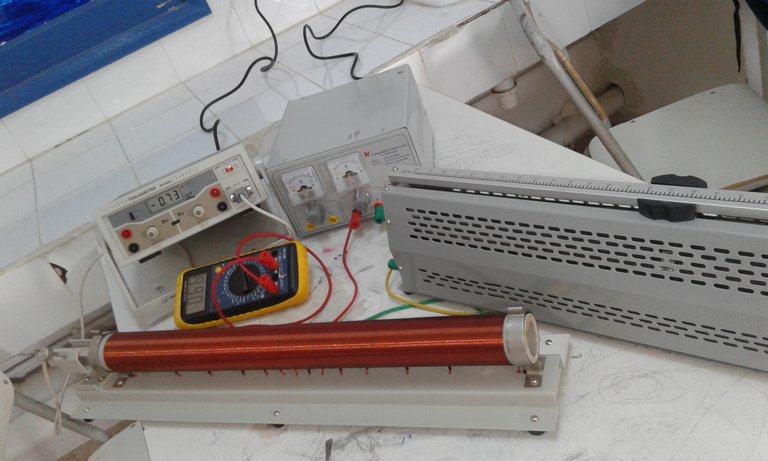🌓🌲Introduction
Hello to all the members of the community. I have just presented an experimental activity, carried out in class with my students, to explain to them whether or not an electric current creates a magnetic field in an electric circuit.
🌓🌲Activity
The series circuit consists of a DC generator, a rheostat, an ammeter and a solenoid of (N) turns and length (L).
A magnetised needle is placed inside the solenoid to detect whether or not a magnetic field is created when electric current flows through the circuit.
The Tesla meter probe placed inside the solenoid will measure the value of the magnetic field as soon as it is created, as shown in the following circuit:

Source image: photo taken, in class, by my mobile phone

Source image: photo taken, in class, by my mobile phone
🌓🌲Observation and interpretation
The needle deviates from its initial direction by a well-defined angle and the tesla-meter indicates a magnetic field value (B).
In the rest of this activity, we study the influence of the characteristics of the solenoid and the current (I) on the value of the magnetic field (B). It is found that :
The measurements carried out lead, finally, to establish the expression of (B) as a function of (I), (N) and (L) such that :

🌓🌲Conclusion
The solenoid, with an electric current flowing through it, creates a magnetic field in and around it and behaves like a straight magnet.
Version Française
🌓🌲Introduction
Bonjour à tous les membres de la communauté. Je viens de vous présenter une activité expérimentale, réalisée en classe avec mes élèves pour leur expliquer si oui ou non un courant électrique crée un champ magnétique dans un circuit électrique.
🌓🌲Activité
Le circuit en série est composé d'un générateur de courant continu, d'un rhéostat, d'un ampèremètre et d'un solénoïde de (N) tours et de longueur (L).
Une aiguille magnétisée est placée à l'intérieur du solénoïde pour détecter si un champ magnétique est créé ou non lorsque le courant électrique circule dans le circuit.
La sonde du Tesla mètre placée à l'intérieur du solénoïde mesurera la valeur du champ magnétique dès qu'il est créé, comme le montre le circuit suivant :

Source image: photo prise, en classe, par mon téléphone portable

Source image: photo prise, en classe, par mon téléphone portable
🌓🌲Observation et interprétation
L'aiguille dévie de sa direction initiale d'un angle bien défini et le tesla-mètre indique une valeur de champ magnétique (B).
Dans la suite de cette activité, on étudie l'influence des caractéristiques du solénoïde et du courant (I) sur la valeur du champ magnétique (B). On constate que :
Les mesures effectuées conduisent, enfin, à établir l'expression de (B) en fonction de (I), (N) et (L) telle que :

🌓🌲Conclusion
Le solénoïde, traversé par un courant électrique, crée un champ magnétique dans et autour de lui et se comporte comme un aimant droit.